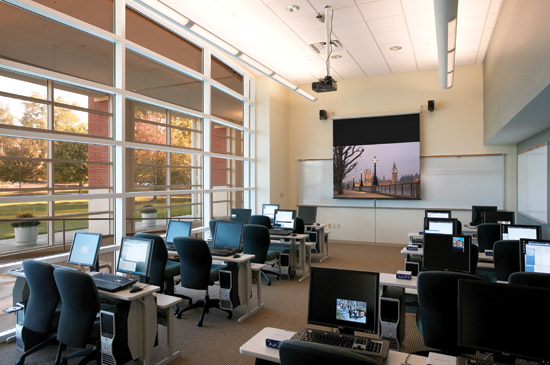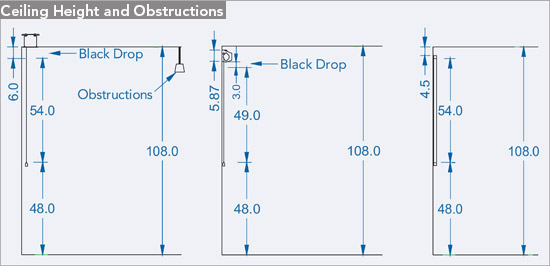Projection Screens Made Simple
Screen Types
Screen type is a basic building block of an effective projection environment. There are five basic screen types.
Electric Screens
Screens are motorized to facilitate lowering and retracting the viewing surface. There are two basic styles: recessed and surface mount. Recessed screens are installed above the ceiling with the bottom of the screen case flush with the finished ceiling. Some of these have trim flanges as part of the case construction that helps complete the installation. Certain models have trap doors to conceal the slot from which the fabric travels while other models are designed to have an open slot at all times. The units with trap doors have either gravity-operated doors or motorized doors. The screens with open slots will have smaller cases and are less expensive.
Some recessed electric screens have two-piece construction; the cases may be shipped, installed, and wired in advance of the viewing surface. The case can be installed during the construction phase without the possibility of damage to the viewing surface. The viewing surface can be added at a later date when the construction has ended.
Wall/ceiling models are surface mounted and are designed with a finished appearance that is aesthetically pleasing and designed to be seen.
To ensure a perfectly flat viewing surface, some models of electric screens are made with tab tensioning technology. This is a construction method that keeps tension on the viewing surface in all directions, ensuring a flat projection surface. This is particularly important when precise and detailed images are being shown. This method is more expensive than the traditional, non-tab tensioned construction. Non-tensioned screens continue to offer quality images at a lower cost for general viewing.
Electric screens have several control options. Typically they are supplied with a line voltage wall switch. Low-voltage control is an option with the low-voltage controller as either an external module or built into the screen motor. Low voltage can be used with a dry contact wall switch, Ethernet, serial communication, and infrared or radio frequency wireless remote. Third-party touch panels are also compatible with low-voltage systems.
Efforts should be made to order the screens with the proper amount of extra drop—additional material at the top of the screen surface—to ensure the best lay flat conditions. Screens are built and tested according to the amount of drop that is ordered. That can be adjusted slightly but adjustment may adversely affect the lay flat qualities.
Changing ceiling height or adding obstructions such as pendant light after screens are ordered could affect proper image height—the screen may not be able to adjust to those changes and in a worst case scenario may have to be replaced.
Manual Screens
Manual screens come in styles similar to those of electric models but typically have either a handle to pull them down, or a crank for tab-tensioned models. Like electric screens, manual screens must be ordered with the correct amount of black drop so they will lay as flat as possible, and altering the ceiling height or adding obstructions may jeopardize the screen's effectiveness.
 |
Manual screens may be either wall or ceiling mounted. Photo courtesy of Draper Inc. |
Fixed Screens
Permanently tensioned to the frame, fixed screens provide a contemporary, theatre-like appearance wherever a permanently mounted front or rear projection screen is required. The viewing surface is flat, which translates to superior picture quality. Because of their simple design and the fact that they are not being rolled up or motorized, fixed screens represent a less costly option. They are typically wall mounted or flown.
Rear Projection Screens
Rear projection screens work well in applications which afford high ambient light. The projection system is placed in a dedicated dark room behind the screen where there is no competing light. While the system achieves an image closer to a flat panel display, a considerable amount of real estate is required behind the screen. Screen surfaces can be either flexible or rigid with various tints of glass or acrylic. Mirror/frame systems are available where the manufacturer can design a custom frame for the application to help reduce the amount of space required behind the screen.
Portable Screens
Portable screens are available in a variety of types. Lightweight models can be carried and typically allow the screen material to be pulled up out of the case. For larger sizes there are folding models that require minimal assembly, with major events often featuring extra large models that require more complicated assembly by a team of people.
Screen Size
How large should a projection screen be? That is a key consideration, and specifiers should be aware that there are different ways of selecting the proper screen size for an application. Many designers use a few rules of thumb for commercial applications based on how the system is going to be used and what type of content will be viewed. Keeping the closest seat to no less than two times the image height will prevent the image from exceeding the audience's primary field of view. The distance to the farthest seat should be no more than six times the image height for presentations and basic video. The distance should be four times the image height for critical content, spreadsheets, and high-definition (HD) presentations. If there is an even mix of content, a distance of five times image height is recommended.
Film content is much wider than most commercial systems and will shrink vertically as in most flat panels used in the home. Consequently it is advisable to go up a size from what is initially calculated, or down in ratio. Many people try to use a flat panel as the primary display in a multipurpose room; however, flat panels are usually not large enough to meet the above-mentioned criteria. While flat panels may seem fine in a small room during video conferencing, for reading data and presentations the sizes are typically not large enough.
The diagram below shows the recommended seating distance to image height ratios dependent on system use and nature of the content. The distance to the back seat is important as it determines the size of the screen. In many conference rooms, the top executive takes a seat at the back of the conference table. If there is a flat panel that is not large enough to allow the data to be read comfortably, the person at the back will have difficulty in following the presentation.
 |
|
Image courtesy of Draper Inc. |
Another issue involved in selecting the proper size of the screen is aspect ratio. The aspect ratio of an image describes the proportional relationship between its width and its height, and is commonly expressed as two numbers separated by a colon, as in 16:9. The aspect ratio of the screen is dependent on the content used most often for the application and the native aspect ratio of the projector. If there will be mostly HD content, then a 16 by 9 screen and projector would be recommended. Typically, it is best to match the aspect ratio of the screen to the aspect ratio of the projector. A wider aspect ratio screen will allow more source content to remain at constant height, without shrinking vertically. Many colleges that provide film studies in auditoriums use digital-cinema model projectors for the widest aspect ratios possible. This is optimal for film content. Digital-cinema model projectors are designed and optimized for movie theaters, but some models can be purchased for applications where film content is important.
 |
|
Image courtesy of Draper Inc. |
The diagram below illustrates three popular applications for electric ceiling-recessed, electric wall-mounted, and fixed-frame projection screens. Most designers prefer the image in commercial applications to be at least 48 inches above the finished floor, leaving a set amount of space to the ceiling for image height, black drop, screen case, or screen frame. For roller type screens, specifying too much black drop will change the way the screen is manufactured. Large adjustments to shorten the screen height will have a negative impact on the ability of the screen to lay flat. Adjusting the screen downwards could cause problems with flatness and could even pose a safety hazard, if there is inadequate fabric wrap around the roller for safety. It is important not to lower a screen so far that the audience can't see it comfortably.
 |
|
Image courtesy of Draper Inc. |









